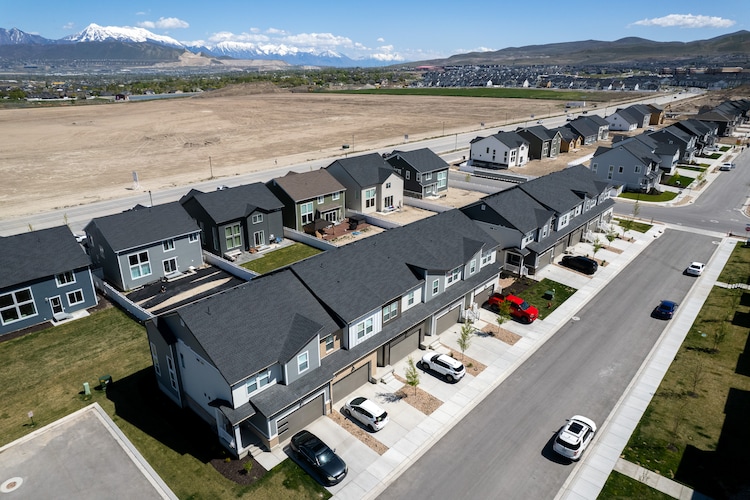This story is part of The Salt Lake Tribune’s ongoing commitment to identify solutions to Utah’s biggest challenges through the work of the Innovation Lab. [Subscribe to our newsletter here]
Kris Crockett has a good salary and enough for a downpayment on a home, but can’t find a house she could afford in Salt Lake City’s Capitol Hill neighborhood.
She’s renting now in Marmalade District and loves it, but hasn’t seen homes for sale below $600,000 or $700,000 — and doesn’t feel comfortable paying $500,000 for a town home.
“It’s kind of demoralizing and depressing how out of reach it is right now and how much money you have to make to afford it,” Crockett said.
Other Utahns said it’s been discouraging, and that they’re considering moving out of Utah to somewhere they can afford to buy a home.

(Trent Nelson | The Salt Lake Tribune) Homes and construction in Riverton's Mountain Ridge neighborhood on Friday, May 3, 2024.
Even Adam Kirkham, president of the Utah Association of Realtors, described the market as frustrating.
Housing affordability is top of mind for many Utahns. It was among registered voters’ top concerns in a recent survey by the Utah Foundation, which found more Utahns think the state is headed down the wrong track than in the right direction.
And homeownership is out of reach for the majority of renters. Just 15% of Utah’s renter households can afford a home that costs between $300,000 and $400,000, according to a report on the state’s housing market. That’s $90,000 less than the median sales price for existing homes so far this year.
A Salt Lake Tribune analysis of data from the Utah Association of Realtors, the U.S. Census Bureau, the National Association of Realtors and CBRE found the typical renter household can only buy a home and spend less than 28% of their income on a mortgage payment in Beaver County.
Even where homes are more affordable in other states, the median renter household income is too low to avoid a mortgage being a cost burden.
There are some positives, Kirkham said, including less competition and a chance to refinance for a better mortgage rate in the future.
People looking to buy homes in Utah also have options to find a home within their budget, he said, including widening their search net, looking to new construction, talking to a real estate agent and connecting with a resourceful lender.
The ultimate solution — , according to realtors, homebuilders, experts and legislators — is more housing inventory.
(Trent Nelson | The Salt Lake Tribune) Homes in Riverton's Mountain Ridge neighborhood on Friday, May 3, 2024.
A typical renter can only afford to buy in Beaver County
Home prices are down from their peak in February 2022, but the median sales price is still close to $500,000. High interest rates compound the problem.
The median sales price for nearly 9,000 existing homes sold this year across Utah’s 29 counties was $490,000 as of March and ranged from $185,000 in Beaver County to $1.3 million in Summit County.
Assuming a 10% down payment and 6.43% interest rate, that means the typical mortgage payment in Utah for new homeowners is $3,043 and varies from $1,149 in Beaver County to $8,026 in Summit County.
A higher down payment would mean a lower loan, but interest rates right now are often higher than 6.43%. Those payments also don’t include property taxes or home insurance costs.
Altogether, that means Utahns need to make about $130,400 a year to afford a mortgage, though the number varies by county from $49,234 to $343,975.
The median income for a renter household is lower than the needed salary in all but Beaver County, where it takes $49,234 to afford a mortgage on a $185,000 median sales price home and the typical renter household has an income of $68,482 a year.
In other counties, renter households fall short of needed income by an average of about $75,000 and as much as $260,000.
Crockett is searching in Salt Lake City, where the median sales price so far this year is $536,000. That requires an income of $154,843, but the median renter household income is $51,710.
When Crockett bought her home in 2019 in Phoenix, it cost $295,000 at a 3% interest rate. She made money when she sold it and has enough to get close to a 20% down payment on a home.
It’s still hard for her to wrap her mind around how much a home in Salt Lake City would cost.
“The prices are crazy,” Crockett said.
(Trent Nelson | The Salt Lake Tribune) Homes and construction in Riverton's Mountain Ridge neighborhood on Friday, May 3, 2024.
Homeownership seems impossible, would blow budgets
Prices may drive Eric Blair to a new career or another state.
Blair has been looking for a home in Davis County. His target home price is $200,000 — significantly lower than the $505,000 that’s the median home sales price so far this year in that county.
He’s been a nurse for a little more than two years and was excited when he became a registered nurse because that almost doubled his pay from other health care jobs.
Blair thought he had an opportunity to own a home — at least a town home or condo — and worked with a real estate agent for more than a year before deciding it “simply wasn’t possible” without a career change, getting married or partnering up with a relative or co-worker to buy.
He’s living with family now to save for a down payment, but said he’s realizing how unattainable it is to buy a home in Utah and is trying to figure out where he needs to be or what job he needs to have to afford it.
Trinity Widdows is looking, along with her two roommates, for a home in or near Springville. Their target price is $380,000, she said, but they’d have to look in Emery County or Price to find something within their budget that also matches their needs.
But Widdows works in Bluffdale, and wouldn’t want to commute daily on US-6 and through Spanish Fork Canyon.
If interest rates or homeowners association payments were lower, she said, they might be able to afford something, but that simply isn’t the case right now.
“There isn’t really anything we can afford [here] in our price range for how much we want that isn’t going to blow our budget completely,” Widdows said.
Even some people who already own homes in Utah are discouraged by the current market.
Taylor Packer bought his house in 2020, right before prices took off, but it’s small and can’t be his “forever home.”
He’s been looking for a home to upgrade, but would have to look “far away from the places I’d want to live here in Utah” to find an affordable option.
“It’s depressing almost, and then I get discouraged and then I look at prices in other states and think, ‘Why do I live here?’” Packer said.
He added while he knows he’s lucky to have found a place at all, he worries about his younger siblings.
Searching outside Utah wouldn’t necessarily help, unless people continue making a similar income to their pay here.
For example, Little Rock, Arkansas, is the most affordable city out of 42 metropolitan areas for which the Tribune analyzed data.
The median sales price for an existing home there at the end of 2023 was $200,000.
Assuming a 10% down payment and 6.43% mortgage, that would be a payment of $1,242 a month, requiring an income of around $53,200 to spend less than 28% of monthly paychecks on a mortgage.
That’s nearly achievable for the typical renter in Salt Lake City but is out of reach for renters in Little Rock, where the median renter household income is about $39,000.
Utah needs thousands more units, building has slowed
Utah likely faces a shortage of at least 37,000 housing units, after the pandemic “produced the shortest and steepest homebuilding expansion and contraction on record,” two experts from the Kem C. Gardner Policy Institute wrote when examining the state’s housing market and outlook last year.
One legislator recently told The Tribune that the main solution to Utah’s affordability crisis is to build more homes.
Yet building, which spiked during the pandemic, is slowing.
Building permits for residential units jumped in 2021 then decreased in both 2022 and 2023, according to a database that Gardner uses to track trends in homebuilding.
Experts expected building to pick back up this year, but there’s still a “massive” shortage, said Jessica Bryce, vice president of marketing for EDGEhomes.
(Trent Nelson | The Salt Lake Tribune) Jessica Bryce in one of EDGEhomes' model homes in Riverton's Mountain Ridge neighborhood on Friday, May 3, 2024.
The Utah-based homebuilder can stand up its Nora model — a three-bedroom home with about 2,400 finished square feet — in four to six months, Bryce said.
EDGEhomes hears three major concerns from potential buyers, she said: Interest rates, affordability and making sure they buy at the right time.
Bryce encouraged people looking to buy to get pre-qualified so they can set their budget, and to buy what they can afford instead of holding out for a dream home.
“We see a lot of people who want to buy what their parents bought 40 years ago,” she said.
Town homes are trending and can “live like a single-family home,” Bryce said, and they’re a more affordable option, as are condos.
(Trent Nelson | The Salt Lake Tribune) Jessica Bryce in one of EDGEhomes' model homes in Riverton's Mountain Ridge neighborhood on Friday, May 3, 2024.
New construction in general also can help people make their budget pencil out, because of concessions and other incentives, Bryce said.
For example, builders can use profit from home sales to “buy down” interest rates either for a few years or permanently — and many are doing so.
Builders want to work with people to get them into a home, Bryce said.
“Our goal is to not turn any buyer away,” she said, by offering multiple options.
She encouraged people to buy as soon as they can instead of trying to game the market.
Kirkham with the Utah Association of Realtors said that could be a good idea. Once interest rates drop, he said, competition for homes will increase again.
Buying now could mean getting concessions and a chance to refinance in the future, he said.
Kirkham and Bryce both recommended working with a lender to go over options and find what works best with their budget.
Megan Banta is The Salt Lake Tribune’s data enterprise reporter, a philanthropically supported position. The Tribune retains control over all editorial decisions.









